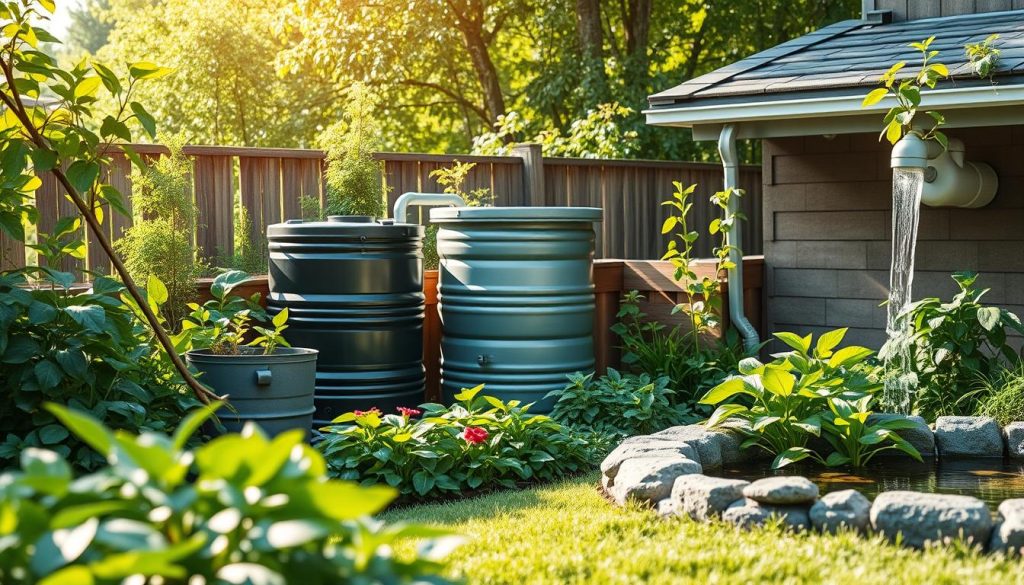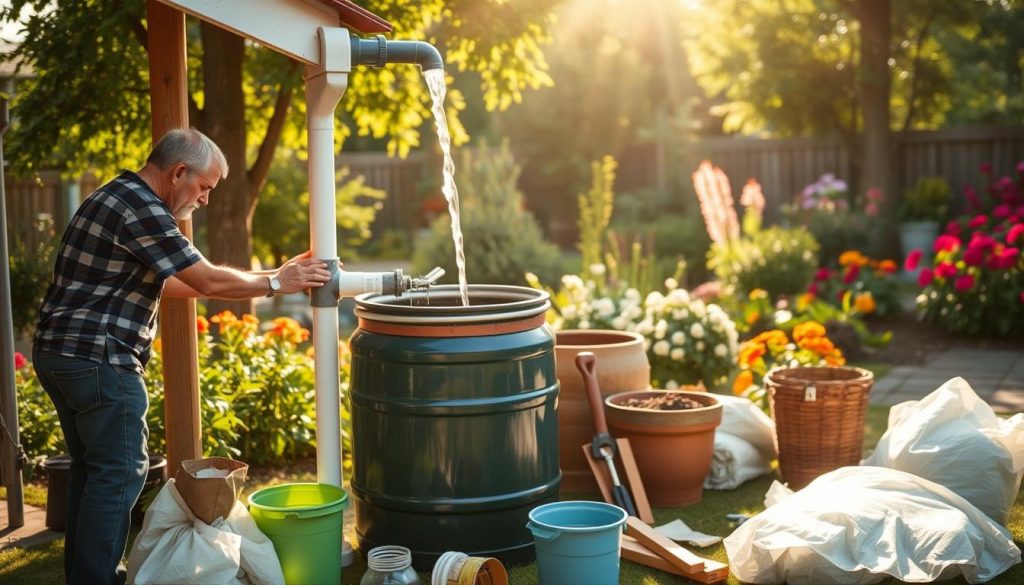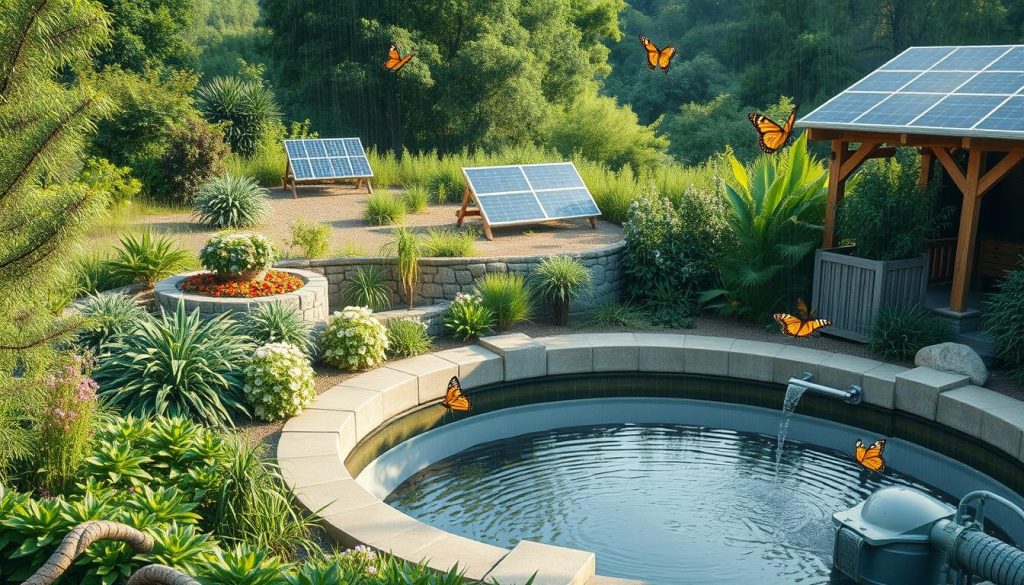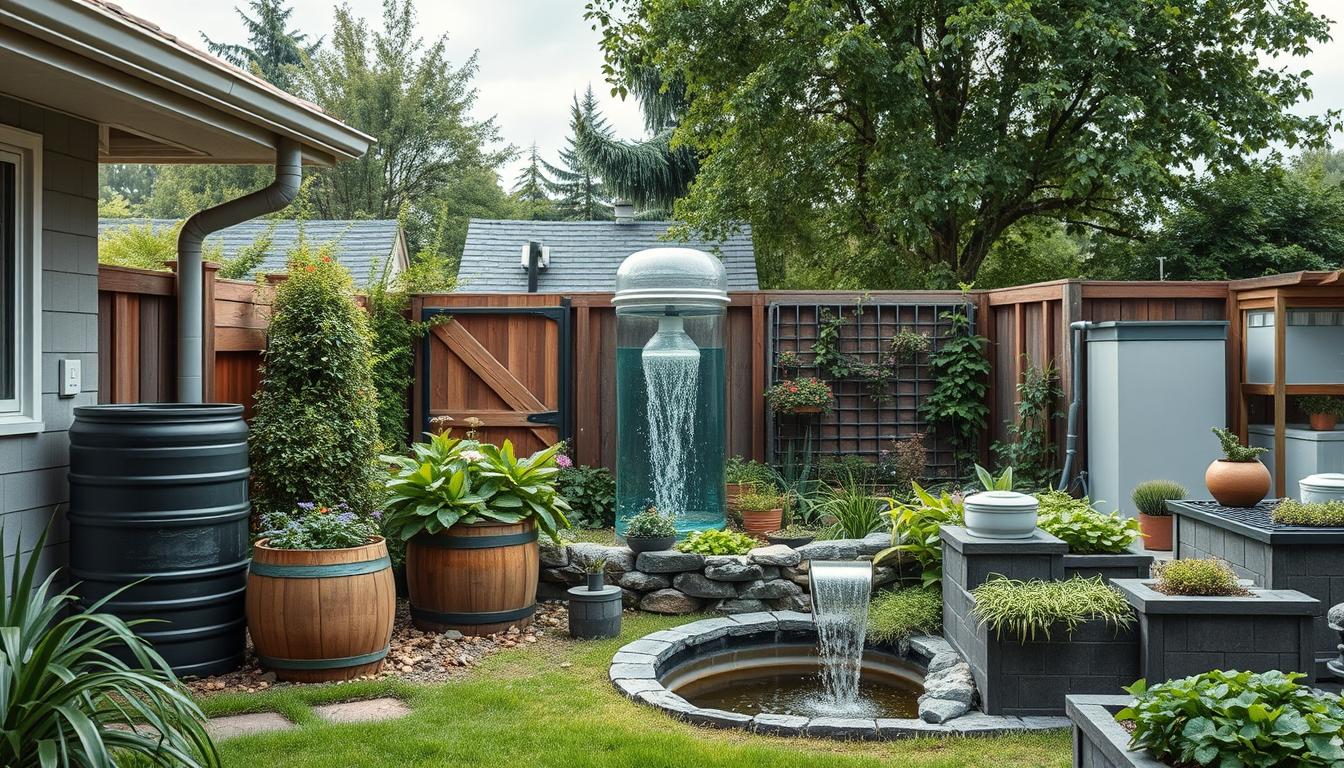I’m excited to share my experience with rainwater collection systems. They’ve been a game-changer for me, helping me use less water and live more sustainably. These systems are great for saving water and cutting down on our use of municipal water.
By using these systems, we can all do our part for the planet. It’s a simple way to live more eco-friendly.
I’ve looked into many rainwater collection options, like barrel systems and cisterns. I’ve also considered green roofs, rain gardens, underground tanks, and DIY setups. These solutions help reduce stormwater runoff and provide natural water for irrigation and other uses.
In this article, I’ll explore the 6 efficient options for rainwater collection. These can help you start your own eco-friendly journey. We’ll look at sustainable water management and rain harvesting systems.
Understanding Rainwater Collection Systems

Rainwater collection systems are key to eco-friendly water solutions. They help cut down on stormwater runoff and ease the load on urban drainage systems. By using these systems, people can help save water and lower their water use. Let’s explore what these systems are, how they function, and their advantages.
Managing stormwater is crucial for these systems. They prevent flooding and erosion. These systems work well with other eco-friendly methods to save water. Benefits include lower water bills, a smaller carbon footprint, and less strain on municipal water supplies.
Key parts of rainwater collection systems include:
- Roof catchments: These are the surfaces that collect and direct rainwater into the system.
- Gutters and downspouts: These transport the collected rainwater from the roof to the storage tank.
- Storage tanks: These hold the collected rainwater until it is used.
- Treatment systems: These may be necessary to remove contaminants and debris from the collected rainwater.
Knowing how rainwater collection systems work and their benefits helps people make smart choices. Whether you want to use less water or help the planet, these systems are a great choice.
| System Component | Description |
|---|---|
| Roof Catchment | The surface that collects and directs rainwater into the system. |
| Gutters and Downspouts | Transport the collected rainwater from the roof to the storage tank. |
| Storage Tank | Holds the collected rainwater until it is used. |
| Treatment System | Removes contaminants and debris from the collected rainwater. |
Option 1: Barrel Systems for Homeowners

As a homeowner, I’ve learned that installing a rain barrel system is a smart move. It helps collect and save rainwater for tasks like watering plants or washing cars. When picking a rain barrel, size, material, and cost are key things to think about.
Think about how much rain your area gets and how big your roof is. A bigger roof means you’ll need a bigger barrel. Also, look at the barrel’s material, like plastic or metal, and how much it costs.
Choosing the Right Rain Barrel
- Size: Consider the amount of rainfall your area receives and the size of your roof.
- Material: Choose from plastic, metal, or wood rain barrels.
- Cost: Determine your budget for the rain barrel and installation.
Installation Tips for Beginners
Setting up a rain barrel system is easy if you follow some simple steps. First, connect the barrel to the downspout to catch the water. Then, add a first flush device to keep out debris. Finally, install a spigot for easy access to the water.
By following these steps and considering the important factors, you can set up a rain barrel system. This will help you save water, lower your water bill, and live more sustainably.
| Rain Barrel Size | Roof Size | Rainfall Amount |
|---|---|---|
| 50 gallons | 1,000 sq. ft. | 1 inch |
| 100 gallons | 2,000 sq. ft. | 2 inches |
Option 2: Cisterns for Larger Collections

Cisterns are a key part of eco-friendly water solutions for big rainwater systems. They help us use less municipal water. Cisterns store lots of water for irrigation and other uses that don’t need drinking water.
Cisterns have been around for ages, and they still work great today. They help catch rainwater and lessen stormwater runoff. This is good for our planet and saves money over time.
What Is a Cistern?
A cistern is a big tank that holds rainwater from rooftops and sidewalks. They can be made of concrete, steel, or plastic. They come in all sizes to fit different needs.
Advantages of Cistern Systems
Here are some benefits of cistern systems:
- Lower water bills: Using rainwater for non-drinking needs cuts down on water costs.
- Less stormwater runoff: Cisterns help control rainwater, preventing floods and erosion.
- More water security: They offer a steady water supply for irrigation and other uses, lessening our need for city water.
Adding cisterns to our water plans makes our water solutions better for everyone. As we look into ways to collect rainwater, cisterns are a big help in managing water sustainably.
Option 3: Green Roofs for Rainwater Management
Exploring rainwater collection options, I’m excited to talk about green roofs. They are layers of plants, soil, and waterproofing that manage rainwater. This helps reduce the load on urban drainage systems and cuts down on stormwater runoff.
Green roofs also help save energy. They insulate buildings and lower the urban heat island effect. This can cut down on energy costs and improve air quality. Plus, they provide homes for plants and animals, boosting biodiversity.
- Reduced stormwater runoff
- Improved air quality
- Increased biodiversity
- Reduced energy consumption
These benefits make green roofs a great choice for managing stormwater and conserving water.
By adding green roofs to our cities, we make them more sustainable. As I look into different rainwater collection methods, green roofs are key. They help manage stormwater and support water conservation.
| Benefits | Description |
|---|---|
| Stormwater Management | Reduces stormwater runoff and alleviates pressure on urban drainage systems |
| Energy Efficiency | Provides insulation and reduces energy consumption |
| Environmental Benefits | Improves air quality and increases biodiversity |
Option 4: Rain Gardens as Natural Filters
Rainwater collection systems help save water and cut down on stormwater runoff. They can include rain gardens, which are shallow spots that catch and clean rainwater. When making a rain garden, think about its size, shape, and where it goes to catch and clean rainwater well.
First, check your yard’s drainage to find the best spot for your rain garden. Pick plants that do well in wet places. Good choices include:
- Native grasses and wildflowers
- Shrubs and trees that like wet soil
- Perennials like irises and sedges that love water
A rain garden in your yard can be both pretty and useful. It helps clean stormwater and stops erosion. Using rain gardens is a smart way to handle stormwater and protect our waterways.
With a well-made rain garden, you get a green, healthy yard. It also helps our community be more eco-friendly. By using rainwater systems, we can lessen our environmental impact and build a greener future.
Option 5: Underground Storage Tanks
Exploring rainwater collection options, I see underground storage tanks as a reliable choice. They efficiently store large amounts of water. This method helps us use less municipal water, making it an eco-friendly solution.
Pros and Cons of Underground Systems
Underground tanks have their perks. They can hold a lot of water, don’t take up much space, and are a steady water source for irrigation and other uses. But, they also have downsides. Installation costs are higher, and maintenance can be tricky.
Maintenance Tips for Longevity
To keep underground tanks in good shape, regular checks and upkeep are key. Here are some tips to remember:
- Check the tank for damage or rust regularly
- Clean the tank and parts often to avoid sediment
- Fix any issues quickly to avoid more damage
By following these tips and weighing the pros and cons, people can decide if underground tanks are the right choice for them.
Option 6: DIY Rainwater Collection Systems
Ready to save more water? Try DIY rainwater collection systems. They let you gather and store rainwater at home. This cuts down on your use of city water and helps the planet.
Easy DIY Projects to Start
Starting with a rain barrel system is simple. It collects water from your roof’s downspout. Use it for gardening, washing cars, or even indoor plumbing.
Another easy project is adding a first flush device. It cleans the water before it goes into your storage. This keeps your water clean and ready to use.
Key Considerations Before Getting Started
First, check how much water your roof can catch. This helps you choose the right size and spot for your system. Also, make sure your project meets local rules and codes.
With careful planning, your DIY system can make a big difference. It’s a great way to save water and help the environment.

